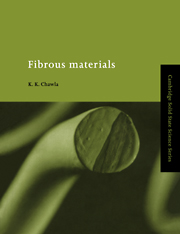Book contents
- Frontmatter
- Contents
- Preface
- Acknowledgments
- Chapter 1 Introduction
- Chapter 2 Fibers and fiber products
- Chapter 3 Natural polymeric fibers
- Chapter 4 Synthetic polymeric fibers
- Chapter 5 Metallic fibers
- Chapter 6 Ceramic fibers
- Chapter 7 Glass fibers
- Chapter 8 Carbon fibers
- Chapter 9 Experimental determination of fiber properties
- Chapter 10 Statistical treatment of fiber strength
- References
- Suggested further reading
- Appendix A Some important units and conversion factors
- Author index
- Subject index
Chapter 7 - Glass fibers
Published online by Cambridge University Press: 13 October 2009
- Frontmatter
- Contents
- Preface
- Acknowledgments
- Chapter 1 Introduction
- Chapter 2 Fibers and fiber products
- Chapter 3 Natural polymeric fibers
- Chapter 4 Synthetic polymeric fibers
- Chapter 5 Metallic fibers
- Chapter 6 Ceramic fibers
- Chapter 7 Glass fibers
- Chapter 8 Carbon fibers
- Chapter 9 Experimental determination of fiber properties
- Chapter 10 Statistical treatment of fiber strength
- References
- Suggested further reading
- Appendix A Some important units and conversion factors
- Author index
- Subject index
Summary
The term glass or a glassy material represents a rather large family of materials with the common characteristic that their structure is noncrystalline. Thus, rigorously speaking, one can produce a glassy material from a polymer, metal or ceramic. An amorphous structure is fairly common in polymeric materials. It is less so in metals, although metallic glass, generally in the form a ribbon, can be produced by rapid solidification, i.e. by not giving enough time for crystallization to occur. In this chapter we describe silica-based inorganic glasses because of their great commercial importance, as a reinforcement fiber for polymer matrix composites and as an optical fiber for communications. Communication via optical glass fibers is a well established field. Crude optical glass fiber bundles were used to examine the insides of the human body as far back as 1960. Since then tremendous progress has been made in making ultra pure, controlled composition fibers with very low optical attenuation. It is estimated that the total worldwide shipment of optical fibers is over US$5 billion per year. Before we describe the processing, structure, and properties of glass fiber, it would be appropriate to digress slightly and describe for the uninitiated, albeit very briefly, the basic physics behind the process of communication via optical glass fibers.
Basic physics of optical communication
Optical glass fiber has many desirable characteristics for communication such as:
▪ large bandwidth over great distances;
▪ protection against electrical interference and crosstalk;
▪ galvanically protected signal transmission;
▪ safety and reliability.
- Type
- Chapter
- Information
- Fibrous Materials , pp. 184 - 210Publisher: Cambridge University PressPrint publication year: 1998



